Basic usage of SLAT
(Estimated time: ~0.5 min)
In this vignette, we show how to use SLAT to align spatial datasets, using Stereo-seq data (Chen. et al) as an example. For demonstration purpose, we only subsample 6,000 cells from every dataset.
You need following files as input:
Chen-Stereo_seq-E15.5-s1.h5ad: down sampled Stereo-seq dataset 1, download from here
Chen-Stereo_seq-E15.5-s2.h5ad: down sampled Stereo-seq dataset 2, download from here
[1]:
# uncomment this if you want to use interactive plot (only works in Jupyter not works in VScode)
# %matplotlib widget
import scanpy as sc
import numpy as np
import pandas as pd
import scSLAT
from scSLAT.model import Cal_Spatial_Net, load_anndatas, run_SLAT, spatial_match
from scSLAT.viz import match_3D_multi, hist, Sankey
from scSLAT.metrics import region_statistics
[2]:
sc.set_figure_params(scanpy=True, dpi=100, dpi_save=150, frameon=True, vector_friendly=True, fontsize=14)
Load datasets
First, we need to prepare the single cell spatial data into AnnData objects. AnnData is the standard data class we use in scSLAT. See their documentation for more details if you are unfamiliar, including how to construct AnnData objects from scratch, and how to read data in other formats (csv, mtx, loom, etc.) into AnnData objects.
Here we just load existing h5ad files, which is the native file format for AnnData. The h5ad files used in this tutorial can be downloaded from here:
https://drive.google.com/uc?export=download&id=1AGxVhgrKF1zD1MNLrC0x032X5uF5blml
https://drive.google.com/uc?export=download&id=1GzTYTS232TPPzlnj9lGrc_CMkhuVM5h4
[3]:
adata1 = sc.read_h5ad('./Chen-Stereo_seq-E15.5-s1.h5ad')
adata2 = sc.read_h5ad('./Chen-Stereo_seq-E15.5-s2.h5ad')
To begin with, we suppose adata.X stores the raw UMI counts of scRNA-seq expression matrix, and adata.obsm['spatial'] stores the spatail coordinates of every cell
[4]:
adata1
[4]:
AnnData object with n_obs × n_vars = 6000 × 28798
obs: 'n_genes_by_counts', 'log1p_n_genes_by_counts', 'total_counts', 'log1p_total_counts', 'annotation', 'Regulon - AI987944', 'Brain_shapes', 'Face_shapes', 'Heart_shapes', 'Lung_shapes', 'Liver_shapes', 'Shapes_shapes', 'Belly_shapes', 'Back_shapes', 'region'
var: 'n_cells', 'n_cells_by_counts', 'mean_counts', 'log1p_mean_counts', 'pct_dropout_by_counts', 'total_counts'
uns: 'region_colors'
obsm: 'spatial', 'spatial_back'
varm: 'PCs'
Then we visualize two datasets colored by cell type:
[5]:
sc.pl.spatial(adata1, color="annotation", spot_size=10)
sc.pl.spatial(adata2, color="annotation", spot_size=10)
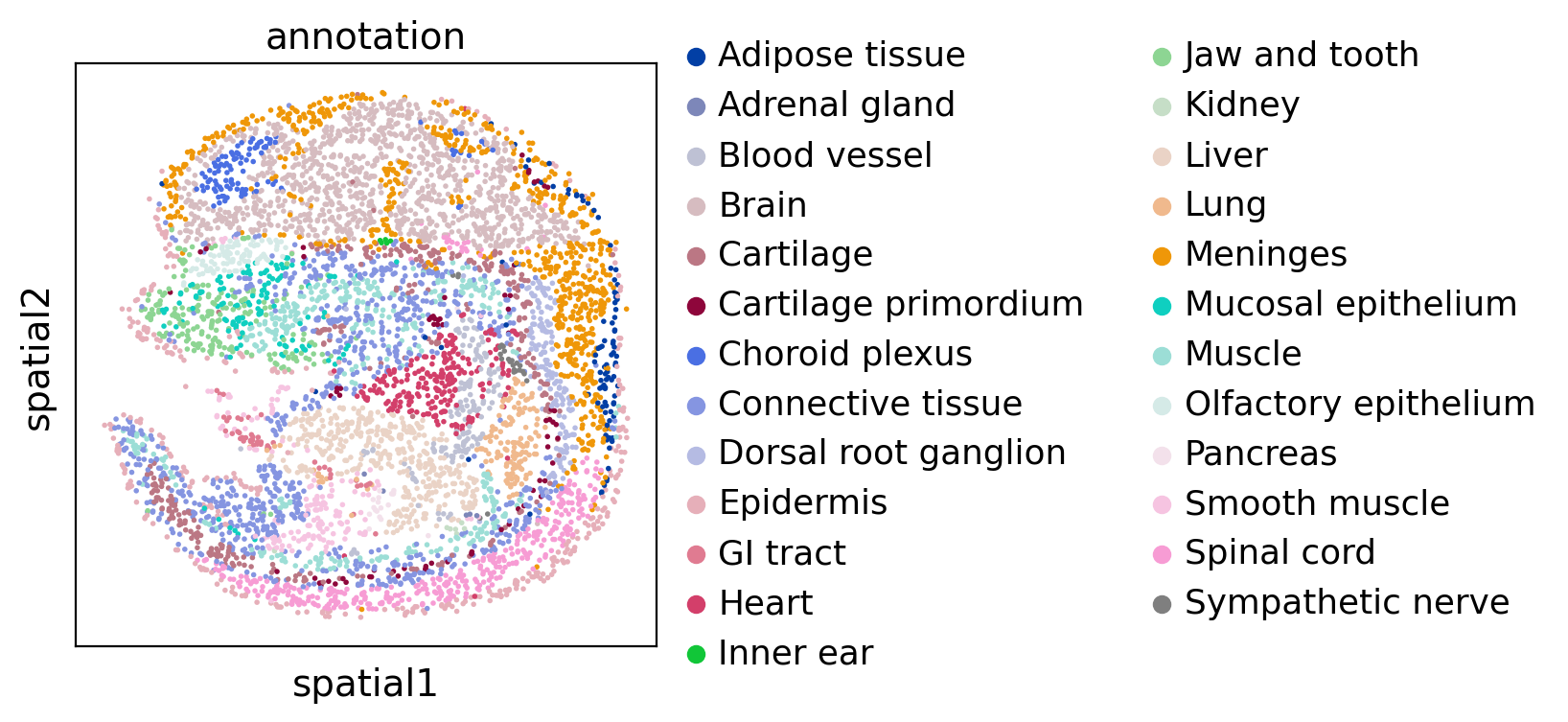
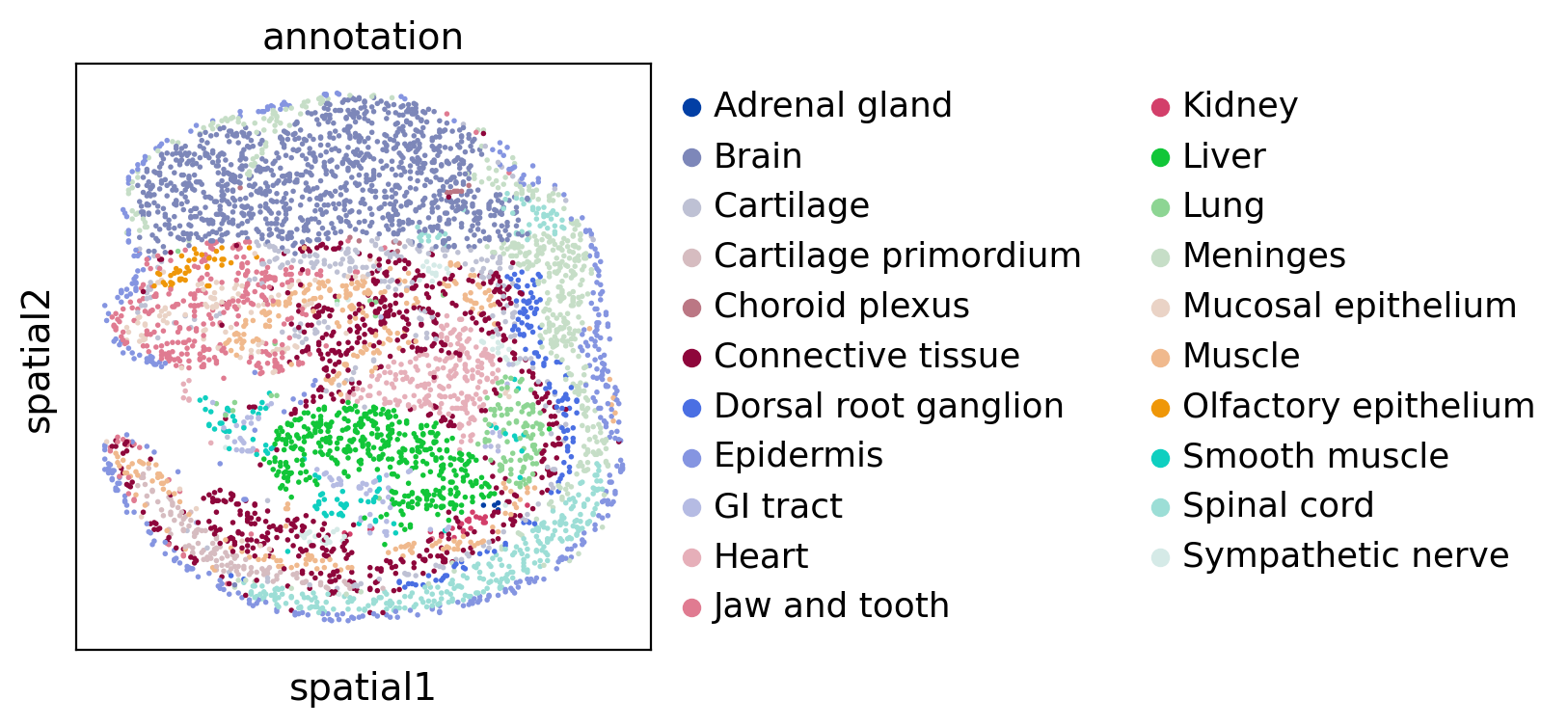
Run SLAT
SLAT need to build neighbor graphs based on cell-cell distance of every dataset respectively.
[6]:
Cal_Spatial_Net(adata1, k_cutoff=10, model='KNN')
Cal_Spatial_Net(adata2, k_cutoff=10, model='KNN')
Calculating spatial neighbor graph ...
The graph contains 68008 edges, 6000 cells.
11.334666666666667 neighbors per cell on average.
Calculating spatial neighbor graph ...
The graph contains 56646 edges, 5000 cells.
11.3292 neighbors per cell on average.
Then, SLAT extract cell gene expression features by a SVD-based matrix factorization algorithm (we named it ‘DPCA’), and extract edges of graphs we built in previous step. > NOTE: SLAT support three built-in embedding algorithms (DPCA, Harmony, and PCA) currently. But you can use any embedding method manually.
[7]:
edges, features = load_anndatas([adata1, adata2], feature='DPCA')
Use DPCA feature to format graph
/rd2/user/xiacr/SLAT/conda/lib/python3.8/site-packages/anndata/_core/anndata.py:1785: FutureWarning: X.dtype being converted to np.float32 from float64. In the next version of anndata (0.9) conversion will not be automatic. Pass dtype explicitly to avoid this warning. Pass `AnnData(X, dtype=X.dtype, ...)` to get the future behavour.
[AnnData(sparse.csr_matrix(a.shape), obs=a.obs) for a in all_adatas],
/rd2/user/xiacr/SLAT/conda/lib/python3.8/site-packages/scanpy/preprocessing/_normalization.py:170: UserWarning: Received a view of an AnnData. Making a copy.
view_to_actual(adata)
/rd2/user/xiacr/SLAT/conda/lib/python3.8/site-packages/scanpy/preprocessing/_simple.py:843: UserWarning: Received a view of an AnnData. Making a copy.
view_to_actual(adata)
/rd2/user/xiacr/SLAT/conda/lib/python3.8/site-packages/scanpy/preprocessing/_simple.py:843: UserWarning: Received a view of an AnnData. Making a copy.
view_to_actual(adata)
Warning! Dual PCA is using GPU, which may lead to OUT OF GPU MEMORY in big dataset!
Then we train SLAT model, it’s very fast and finish in 10s. > Warning: SLAT default hyperparameter can handle most situation. You should not change them unless you know details very well.
[8]:
embd0, embd1, time = run_SLAT(features, edges)
Choose GPU:7 as device
Running
---------- epochs: 1 ----------
---------- epochs: 2 ----------
---------- epochs: 3 ----------
---------- epochs: 4 ----------
---------- epochs: 5 ----------
---------- epochs: 6 ----------
Training model time: 1.17
Aligning and visualization
Then we align the datasets base on SLAT embedding
[9]:
best, index, distance = spatial_match(features, adatas=[adata1,adata2], reorder=False)
[10]:
adata1_df = pd.DataFrame({'index': range(embd0.shape[0]),
'x': adata1.obsm['spatial'][:,0],
'y': adata1.obsm['spatial'][:,1],
'celltype': adata1.obs['annotation']})
adata2_df = pd.DataFrame({'index': range(embd1.shape[0]),
'x': adata2.obsm['spatial'][:,0],
'y': adata2.obsm['spatial'][:,1],
'celltype': adata2.obs['annotation']})
matching = np.array([range(index.shape[0]), best])
best_match = distance[:,0]
Then we visualize the cell to cell matching, colored by cell type. By default, Blue line means correct match of cell type, red line is the opposite.
[25]:
multi_align = match_3D_multi(adata1_df, adata2_df, matching,meta='celltype',
scale_coordinate=True, subsample_size=300)
multi_align.draw_3D(size=[7, 8], line_width=1, point_size=[1.5,1.5], hide_axis=True)
/tmp/ipykernel_3129559/4137928538.py:73: FutureWarning: The series.append method is deprecated and will be removed from pandas in a future version. Use pandas.concat instead.
self.celltypes = set(self.dataset_A[meta].append(self.dataset_B[meta]))
dataset1: 25 cell types; dataset2: 21 cell types;
Total :25 celltypes; Overlap: 21 cell types
Not overlap :[['Inner ear', 'Blood vessel', 'Pancreas', 'Adipose tissue']]
Subsample 300 cell pairs from 5000
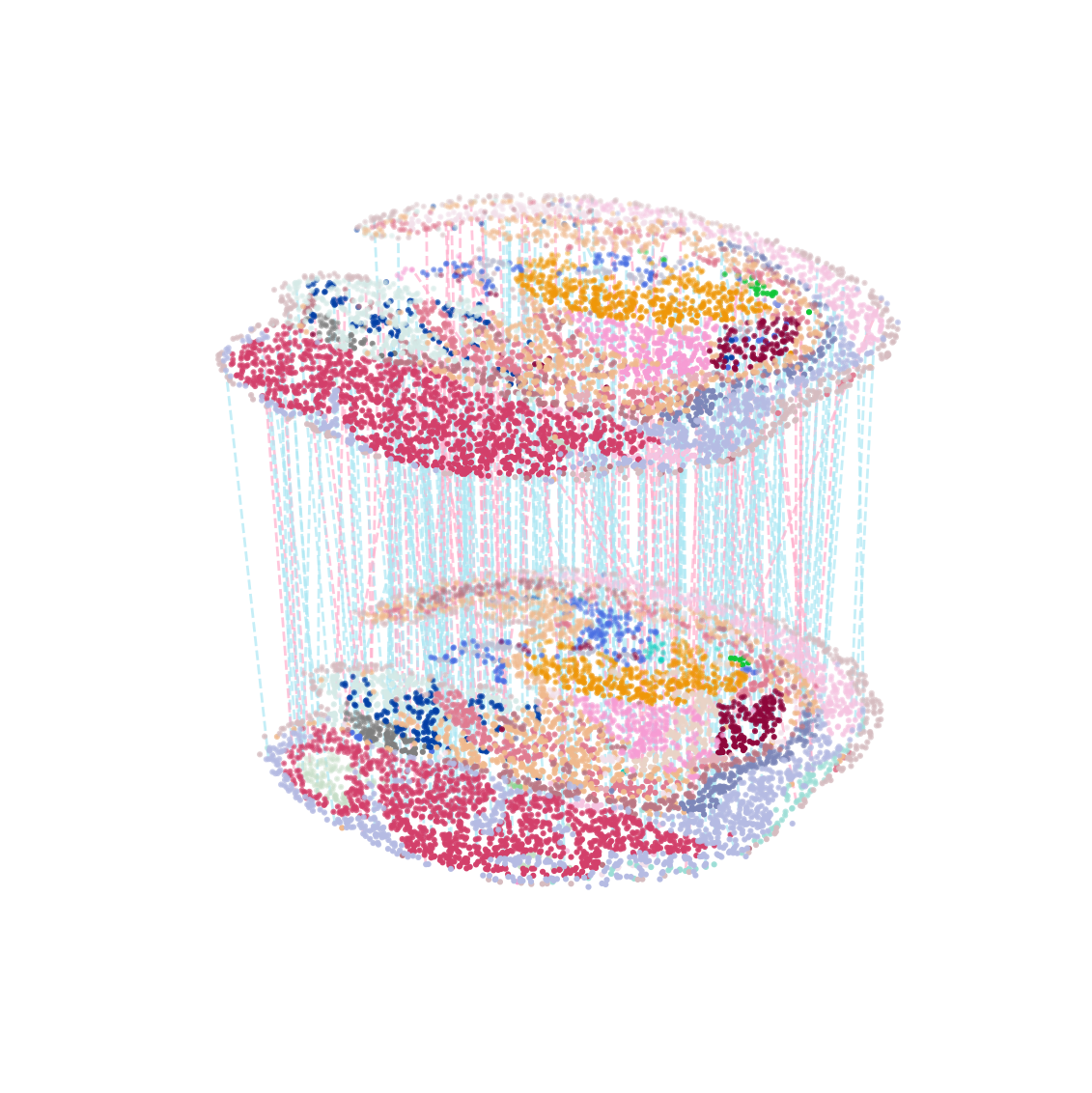
Similarity score
Similarity score means the confident of SLAT alignment. Regions with low similarity scores may 1) have biological difference; 2)cause by technology variance. We can also plot the distribution of the similarity score of aligned cells.
[12]:
%matplotlib inline
hist(best_match, cut=0.8)
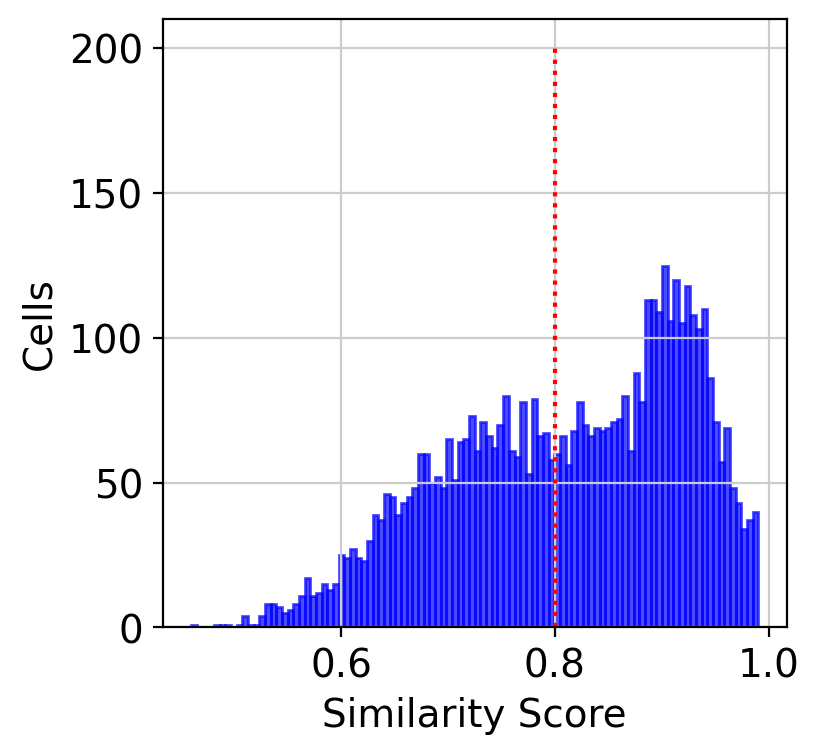
We also can visualize the similarity score spatially.
[13]:
adata2.obs['low_quality_index'] = best_match
adata2.obs['low_quality_index'] = adata2.obs['low_quality_index'].astype(float)
[14]:
sc.pl.spatial(adata2, color='low_quality_index', spot_size=20, title='Quality')
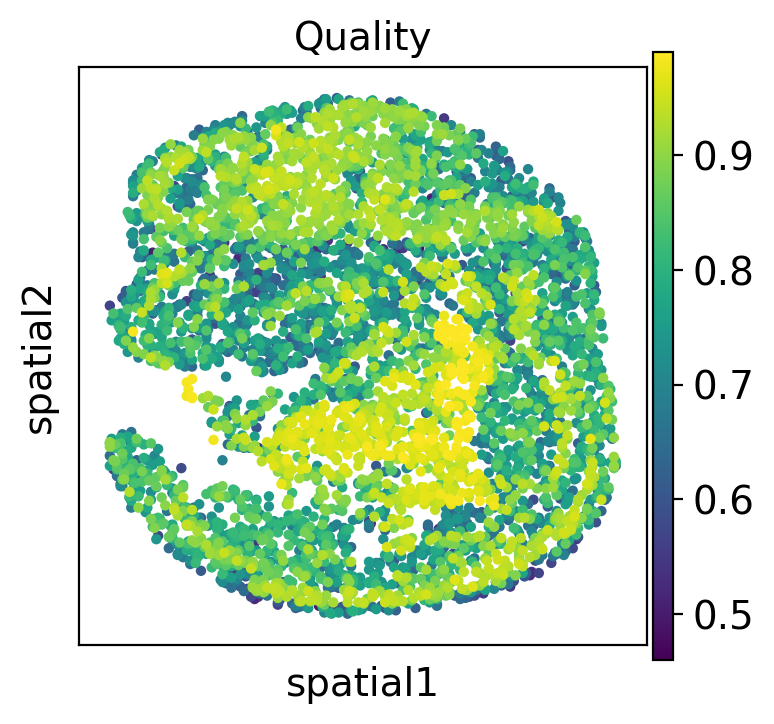
Cell type level analysis
We can check the cell type level corresponding via Sankey diagram.
[15]:
adata2_df['target_celltype'] = adata1_df.iloc[matching[1,:],:]['celltype'].to_list()
matching_table = adata2_df.groupby(['celltype','target_celltype']).size().unstack(fill_value=0)
[ ]:
Sankey(matching_table, prefix=['E15.5_E1S1','E15.5_E1S2'])